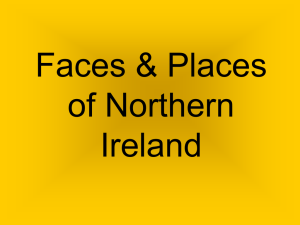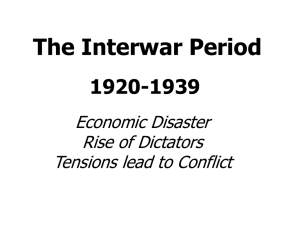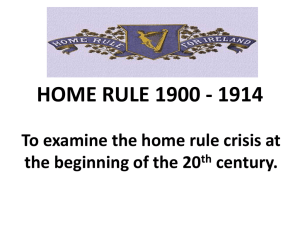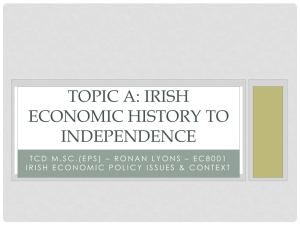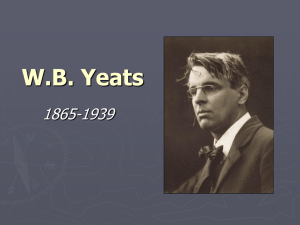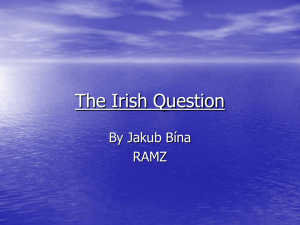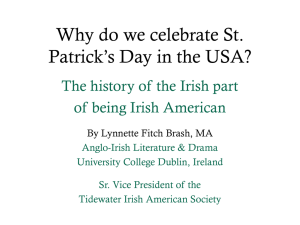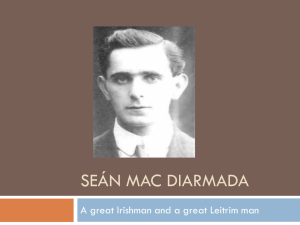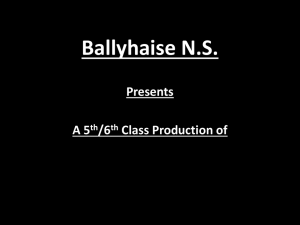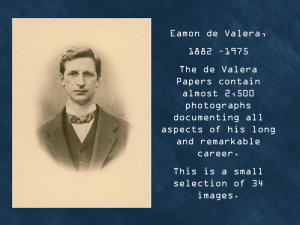File
advertisement
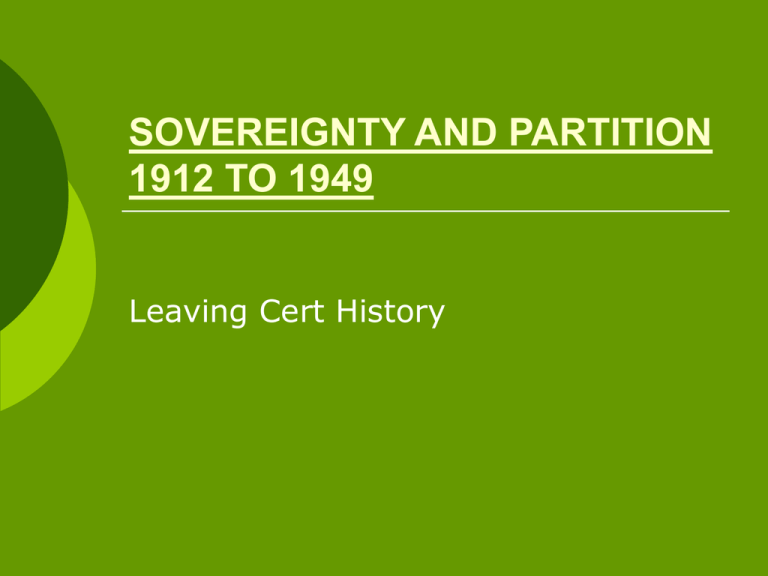
SOVEREIGNTY AND PARTITION 1912 TO 1949 Leaving Cert History IRELAND AT THE START OF THE 20TH CENTURY Ireland and the UK A rural country Direct rule. 103 of 665. Men over 21 only. Lord Lieutenant or Viceroy Chief Secretary a cabinet member. Under Secretary in Dublin Castle. Could do nothing without approval from Westminster. RIC and DMP officers English. Union or Self-government? The Unionist View Reasons for and against: Ethnic identity Religion Economic considerations (fear of trade barriers) Differences Between Northern and Southern Unionists Northern: All classes Presbyterian Orange Order Industrialised Represented by Ulster Unionist Council Southern: Wealthy minority Big business and House of Lords C of I Represented by Irish Loyal and Patriotic Union UUC and ILPU joined to form the Unionist Party in 1886 under Ernest Saunderson Union or Self-government? The Nationalist View Moderate Nationalism Nationalist Party (Home Rule) Redmond, Dillon, and Joe Devlin (Belfast) 80 MPs Sinn Fein Griffith’s ‘Resurrection of Hungary’ and Dual Monarchy Self-sufficiency (protectionism) Peaceful Failed due to success of Home Rule Name was good and became a catchall name for Irish Ireland groups. Cultural Nationalism and the Emergence of New Movements GAA Gaelic League Irish Literary Revival Patrick Pearse Joined Gaelic League at 16 Became editor of ‘An Claidheamh Soluis’ Trained lawyer but became a teacher. Wrote: ‘Murder machine’ about Irish education system. Founded St Enda’s School in 1908 Seemed happy with Home Rule for a while. Went broke and students left. This and the Home Rule crisis in 1912 seems to have turned him from being a language enthusiast and educationalist to being a republican separatist Socialism James Connolly and Jim Larkin. Employers force employees to quit Unions. Connolly founded Citizens Army. 1913 Lockout and ITGWU William Martin Murphy and Employers association win. Feminism Hannah SheehySkeffington and the Irish Women’s Franchise League. Home Rule party did not like the idea or the violence. Countess Markievicz. Soup kitchens in Lockout. With Bulmar Hobson started Fianna Eireann. Joined Citizen’s army. Images of Suffrage THE HOME RULE CRISIS: 1910-1914 Opening the Way for Home Rule Redmond, Dillon and Devlin V Carson and Craig British Reasons against Home Rule: Strategic Reasons Break-up of the Empire Racism Reasons for: Embarrassed by bad government (Famine and poverty) Clear will of the majority of the Irish Disruption of parliament THE HOME RULE CRISIS: 1910-1914 Conservatives under Bonar Law were Unionist. Liberals under Asquith were officially for Home Rule. Labour for also but small. 1909 Lloyd George’s Budget 1910 Home Rule Party wins balance of power 1911 Parliament Act 1912 Home Rule Act. Westminster still had control of Foreign affairs, foreign trade, army, police, post, the monarchy and taxation. Unionists Oppose Home Rule September 1912 Solemn League and Covenant. 1913 UVF Partition and the Nationalist Response Craig for and Carson against. Redmond against but Liberals said talk or no Home Rule. Secret talks with Carson concluded that in order to avoid civil war, Ulster would be excluded from Home Rule. What was Ulster? It was agreed that Antrim, Armagh, Down and Derry were certain but by 1914 the fate of Tyrone and Fermanagh was undecided. IRB and the National Volunteers Revival of IRB by Hobson, MacCullough, MacDiarmada, and Clarke. 1913 Eoin MacNeill’s ‘The North Began’ November 1913. The Irish National Volunteers to ensure Home Rule. Women not allowed so Cumann na mBan set up (Hannah Sheehy Skeffington and Countess Markevitz) IRB infiltrate volunteers. Intend to use it for a rebellion. IRB and the National Volunteers March 1914 Curragh Mutiny April Larne GUN RUNNING. June Redmond took over the Irish Volunteers. July Howth GUN RUNNING July Buckingham Palace Conference. A worried King George V brought all sides together but failed. IRELAND 1914-1918 CRISIS AND CHANGE Opening the Way for Home Rule Reasons why Redmond at Woodenbridge urged Volunteers to join British Army: Catholic Belgium To show British fears concerning HR unfounded. To win a sympathetic ear in discussions about Tyrone and Fermanagh ‘Over by Christmas’. Ireland and WW1 206,000 joined up. UVF joined the 36th Ulster Division and were slaughtered at the Somme. Irish National Volunteers split up between the 10th and 16th. Did not have their own officers. Great losses at Gallipoli and in France. Irishmen joined because: Redmond and Carson told them Idealism Money Nationalism or Unionism Economic Effects Boom for farmers, shipbuilding and linen. Emigration to UK banned. Unemployment, so wages did not go up and opportunities for women did not increase either. Reasons for Redmond’s decline in popularity HR already won Ulster nationalism felt betrayed by partition. Failure to get an Irish Brigade War not over by Christmas Planning a Rebellion Split in the Irish National Volunteers. 10000 of 180000 under MacNeill became the Irish Volunteers They paraded with rifles. Redmond knew MacNeill would not rebel unless the British tried to disarm them. He told Augustine Birrell (Chief Secretary) that they were harmless and to let them alone. IRB divided Hobson wanted no rebellion without the consent of the majority of the Irish people. MacDiarmada and Clarke forced him off the Supreme Council. They set up a Military committee joined by Pearse, Plunkett, McDonagh and Ceannt Roger Casement Sent to Germany to get troops, arms, and Irish POWs. So few POWs were interested the Germans sent 20,000 captured rifles and 10 machine guns but no troops. Casement came home on a submarine to stop the rebellion as he felt it had no chance but was captured on Banna Strand. The British thought he was the main leader and the rebellion would not go ahead. Rebellion Plans Obsessed with secrecy, so numbers were always going to be small. To put up a good fight always seemed to be the aim. Clarke and MacDiarmada hoped to win. Pearse, Connolly, MacDonogh and Plunkett on for a ‘Blood Sacrifice’ War up to WW1 was romantic and honourable death admired. Connolly, a socialist, was not trusted and not told until he threatened to go it alone. The Aud: The plan in Tatters. Arrived as planned on Friday but the plans had changed to Sunday and they had no radio. Captured and scuttled. Castle Document Forged. Leaders to be arrested. MacNeill ordered rising for Sunday. He found out and heard of the Aud and called it off. The Rising and the Aftermath. Easter Monday. Bank holiday. Fairyhouse horse meeting many out of town. Pearse and Proclamation (outside GPO). Connolly, once a soldier, in charge of military operations. Confusion limited rising to Dublin and Thomas Ashe in Ashbourne. The Rising and the Aftermath. GPO, Four Courts, South Dublin Union, St. Stephen’s Green, Boland’s Mill and Jacobs Factory. Failure to take Dublin Castle important. The Rising and the Aftermath Cumann na mBan were nurses, secretaries and couriers. Tuesday, General Maxwell put in charge. Helga shells GPO from Liffey. GPO on fire. Mount St Bridge. The Rising and the Aftermath Saturday surrender unconditionally. 450 dead. Most civilians. City ablaze. Rebels needed protection. It took a week for people to realise what it was all about. Reaction and Changing of minds. British and Unionists saw it as a stab in the back Dillon warned Redmond who warned Asquith not to overreact, but Maxwell given a free hand. 3000 arrested. 88 death sentences. Shootings in batches over 6 days. William Pearse and Connolly created sympathy. Dillon rushed to House of Commons and stopped the killings but the damage was done. The rest got life. David Lloyd George Lloyd George Became PM in 1916. He persuaded Redmond to accept a temporary 6 counties but told Carson it was permanent. Nationalists furious with partition. 1917 Lloyd George proposed Conscription. This really helped Sinn Fein. The Victory of Sinn Fein To win public opinion in the USA, Lloyd George released the prisoners from Frongoch. This included Collins and Griffith. ‘Sinn Feiner’ had come to mean anyone who was nationalist but not a Home Ruler. Griffith had not even taken part. He had offered but Pearse sent him home to work on propaganda. Ashe died on hunger strike and Collins became President of the IRB. The Victory of Sinn Fein Count Plunkett’s victory in the North Roscommon byeelection showed the IRB that politics could be useful. 1917 DeValera won east Clare. Griffith stepped aside and the new Sinn Fein emerged. Abstention and a republic was its aim. Lloyd George set up ‘The Irish Convention’ to sort out differences between Unionist and Nationalists but SF would not attend and it failed. The Victory of Sinn Fein 1918 Conscription bill passed and support for SF increased. 1918 the ‘German Plot’ to import arms led to the arrest of 73 SF including De Valera. More support. This also left the more militant in control. The 1918 General Election In Britain Lloyd George’s coalition government succeeded but depended on Conservatives and this affected decisions regarding Ireland. Redmond was dead so John Dillon was leader of Home rule party. SF members were young and well organised. Their leaders in jail, meetings banned all added to support. The executions, the ‘German Plot’ and conscription helped. The 1918 General Election They promised a republic without any talk of fighting. Women over 30 could now vote if they or their husbands paid rates. Sinn Fein won 73 and Home Rule won 6. Markievicz was the first woman elected to the House of Commons Unionists increased their seats from 19 to 26. The 1918 General Election The Irish people had voted for a republic. For some, like Griffith, this meant more independence than home rule. To Collins and De Valera this meant a completely separate state. This ambiguity helped contribute to Civil War. REVOLUTION AND PARTITION The Government of Dáil Éireann January 1919 First Dail HR or Unionists did not attend. Only 27 attended as most of the rest were in jail over the ‘German Plot’. Collins and Boland helping Dev escape from Lincoln Jail. Repeated the Declaration of the Republic (Proclamation) Message to the Free Nations of the World. Rejected by W Wilson who did not want to offend GB. Passed the Democratic Programme. This was a promise to implement educational and social reform. Largely to reward the Labour Party for not contesting the election. April: Dail Government formed De Valera president. Collins Minister for Finance Cathal Brugha Defence Countess Markievicz Minister for Labour W T Cosgrave Mister for Local Government Young, inexperienced, no civil service, no police or army. Few took them seriously. June 1919 to December 1920 De Valera in the USA Got involved in quarrels between leading IrishAmericans. Failed to get recognition from either big party. Got a lot of money June 1919 to December 1920 De Valera in the USA At Home Griffith was Acting President. He set up an effective court system where local priests, doctors or teachers acted as judges. Punishments were beatings, banishment and execution. Did a lot to make the new government acceptable. Collins sold government bonds while on the run. Cosgrave made sure Sinn Fein controlled most councils and tried to end corruption. Sean T O Kelly in Paris after the Peace Conference and worked to win recognition.
